The military-political position of Russia at the turn of the XVII-XVIII centuries. Azov trips
During this period, the first places in the power of the fleets occupied England and Holland. In these countries, the revolution cleared the way (and in a very bloody way) for capitalist development. Strong fleets possessed by Spain, Portugal, France, Venice, the Ottoman Empire, Denmark and Sweden. All these states had a vast sea coast, a long tradition of navigation. A number of states possessed huge colonial empires - Spain, Portugal, or they were built in full swing - England, Holland, France. The resources of the conquered territories gave a powerful impetus to development.
Russia was in a different position. Our power was the heir to the ancient maritime traditions (to bind history the emergence of the Russian fleet with the borders of the era of Peter I - a clear mistake). In the period of the Old Russian state, the Black Sea was called the Russian Sea, and the Baltic Sea was the Varangian Sea - the Varangians controlled it long before the flowering of the German Hansa (and the Hansa was created on the basis of the Slavic cities and their trade relations). But by this period, Russia-Russia was pushed back into the continent. In the northwest, access to the Baltic Sea was blocked by Sweden. The Kingdom of the Swedes at that time was a first-class great power, having a professional army and a strong fleet. The Swedes seized the Russian lands along the shores of the Gulf of Finland, controlled a large part of the southern Baltic, turning the Baltic Sea into a “Swedish lake”. Only on the coast of the White Sea (hundreds of kilometers from the main economic centers of Russia) did we have the port of Arkhangelsk. He gave limited opportunities for maritime trade - was remote, and in winter navigation was interrupted due to the severity of the climate.
Access to the Black Sea closed the Crimean Khanate (vassal Ports) and the Ottoman Empire. The Turks and the Crimean Tatars held in their hands the entire northern coast of the Black Sea, with the mouths of the Danube, Dniester, Southern Bug, Dnieper, Don, Kuban. And, on a part of these territories, Russia had historical rights - they were part of the Old Russian state.
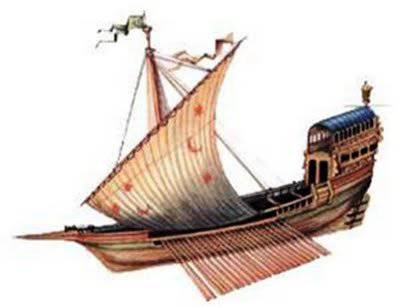 The situation was aggravated by the fact that the Ottoman Empire, the Crimean Khanate, Sweden were hostile states of Russia. The sea coast in the south and north-west was a convenient base for an offensive on the Russian lands. On the southern frontiers, there was an almost uninterrupted battle with the hordes of the Crimean Khanate and other predators, if there were no major campaigns, then small raids, raids by enemy units were commonplace. The Crimean Khanate was a real parasitic public entity that lived at the expense of robbery, hijacking for sale into slavery of thousands and tens of thousands of Slavs. Only in the first half of the 17 century, the Crimean hordes were hijacked and sold into slavery to 200 thousand Russians.
The situation was aggravated by the fact that the Ottoman Empire, the Crimean Khanate, Sweden were hostile states of Russia. The sea coast in the south and north-west was a convenient base for an offensive on the Russian lands. On the southern frontiers, there was an almost uninterrupted battle with the hordes of the Crimean Khanate and other predators, if there were no major campaigns, then small raids, raids by enemy units were commonplace. The Crimean Khanate was a real parasitic public entity that lived at the expense of robbery, hijacking for sale into slavery of thousands and tens of thousands of Slavs. Only in the first half of the 17 century, the Crimean hordes were hijacked and sold into slavery to 200 thousand Russians. The Turks, relying on numerous fortresses, outposts, and the forces of the Crimean Khanate, not only kept South Russian lands under their control, but also planned to expand their zone of influence. The Ottoman Empire even at the end of the 17 century experienced a serious internal crisis, but nevertheless it was a powerful empire with enormous military and economic resources. Her possessions stretched from Gibraltar to the Balkans, the northern coast of the Black Sea and the Indian Ocean. The Ports Army was considered one of the strongest and most numerous in the world, the Navy was significant in terms of the number of pennants and had a vast combat experience. For two centuries the Turks fought with land forces and the Navy of Austria, France, Spain, Venice, the Order of Malta, Tuscany. Istanbul had beautiful forests to build ships from the Black Sea coast, hemp came from Egypt (fibers from cannabis stalks, they were used to make ropes and ropes) and canvas, and Albania and Wallachia came from tar and lard. The Turks had excellent harbors in the Black Sea, the Bosphorus, the Sea of Marmara. Military specialists (for example, gunners) were hired from the French, the British, the Dutch. Slaves for rowing ships supplied the Crimean Tatars. The Turkish Navy dominated the Black Sea, could quickly replenish forces from the Bosphorus and the Mediterranean, transfer additional troops to the garrisons of the Northern Black Sea region.
Access to the Baltic and Black Sea was important both from the point of view of military-strategic necessity (access to the natural lines of defense), restoration of historical justice, and from economic considerations. The isolation from the main sea trade routes of Europe (Baltic - North Sea - Atlantic, Black Sea - Mediterranean - Atlantic) adversely affected the economic development of the state. Therefore, the struggle for access to the seas has become paramount to the future of Russia.
First Azov campaign 1695 of the year
Since the XVI century, Russia fought against the Crimean and Nogai hordes. Moscow wanted to secure its southern frontiers, to begin processing the rich southern lands (the so-called “Wild Field”), to get access to the Black and Azov Seas. In the course of this struggle, Russia clashed with the Ottoman Empire, patronizing the Crimean Tatars. One of the military strongholds on these lands was the Turkish fortress of Azov, located at the confluence of the Don River into the Sea of Azov.
By the time the princess Sophia was overthrown (1689 year), Russia was at war with the Ottoman Empire. Russia joined the Holy League, created in 1686, in 1684. This alliance included the Holy Roman Empire, the Republic of Venice and the Polish-Lithuanian Commonwealth, it was directed against the Ottoman Empire. In 1687 and 1689, under the leadership of Prince Vasily Golitsyn (a favorite of Sophia), campaigns were undertaken against the Crimean Khanate, but they did not succeed. Military operations were stopped, but Russia and the Ottoman Empire did not conclude peace. The continuation of the war with Porto became the priority of Peter I's foreign policy in the early years of autocracy. There were several reasons for this: first, Moscow was at war with Istanbul, and the allies in the anti-Turkish alliance demanded that Peter I continue military operations; secondly, the war with Turkey seemed to be an easier task than the conflict with Sweden, closing its way to the Baltic Sea (Turkey fought on other fronts and could not throw considerable forces into the war with Russia); thirdly, the capture of Azov could protect the southern borders of Russia from the raids of the Crimean Tatars; Fourthly, Peter dreamed of creating a fleet, the establishment of the Azov flotilla could be the first step towards the realization of these plans.
It was decided not to attack the Crimean Khanate, as during the Golitsyn campaigns, but to strike at Azov. Changed and the route - decided to go not through the desert steppes, and in the areas of the Volga and the Don. The first army under the command of Count Boris Petrovich Sheremetyev, together with the Cossacks of Mazepa, was to operate in the lower reaches of the Dnieper. The second army under the command of Peter I, Fyodor Golovin, Patrick Gordon, Franz Lefort was to take Azov.
Azov was one of the main outposts of the Ottoman Empire in the region. The city was fortified with powerful stone walls with bastions. On both sides of the Don, powerful towers stood, stretching chains between them to stop the passage of ships. The preparation of the campaign on the Azov was conducted in secret, the army was formed from the best regiments of the nascent regular army — Preobrazhensky, Semenovsky, Lefortovo, Butyrsky, and the archers included in it. In the winter and spring of 1695, on the Don, transport ships were built: planes (river sailing-rowing vessel of length 25-30 m), sea boats and rafts for the delivery of troops, artillery, ammunition and food.
In the spring of 1695, the army came out of Moscow; on the Strug and other river transports it went along the Moscow River, the Oka, the Volga. On the Volga, they reached Tsaritsyn, where they switched to the Don. In early July, the army was at Azov and blocked it from land. 2 July began siege work and shelling of the fortress. The Russian army was able to capture the towers (fortifications) above Azov (July 14 - July 16), which allowed them to bring cargo to the Russian military camp itself. By the beginning of August, the advanced trenches led approximately 50 meters to the shaft of the fortress.
The Russian command considered that the ground forces were sufficient for an assault, but underestimated the importance of the Turkish fleet. From Istanbul to Azov constantly sent ships, ships that threw fresh units (to replenish the garrison, which suffered from shelling), brought weapon, ammunition, food. At that time, the Black Sea was actually a “Turkish lake”; Russia could not prevent the enemy.
Early in the morning of August 5 the storming of the fortress began. More than 4 thousand Russian soldiers rushed to the enemy stronghold for a few hours was a bloody battle. The Turks fought back with great stamina. All attempts to seize the fortifications were repulsed. The Cossack detachment, which was supposed to attack the fortress from the Don, coming up on their boats, was also repelled.
The unsuccessful assault revealed a number of serious shortcomings in the Russian army: they could not establish a blockade of the fortress from the sea, there was not enough experience in the siege of fortresses, lack of organization and discipline affected, there was no unity of command, a single high command. Golovin, Lefort, Gordon could not organize concerted actions, quarreled. Peter could not coordinate their actions.
September 25 Russian troops went to the second assault. He was better prepared and organized, but the Turks repulsed him too. As a result, Peter decided to lift the siege and withdraw the troops to the winter quarters (during the winter, military operations in Europe were mostly not conducted, due to the natural conditions - cold, mudslides, lack of roads, supply difficulties, etc.). October 20 troops withdrawn. 3 thousand detachment left to protect the captured fortifications.
The Dnieper army, led by Sheremetyev, repulsed three fortresses from the Turks: July 30 - Kyzy-Kermen (in Ukrainian Berislav), August 1 - Eski-Tavan, August August 3 - Aslan.
In Istanbul, the departure of the Russian army from Azov was perceived as a victory. The Turkish command decided that in the near future the Russians would not be able to repeat the siege and should not wait for the threat. But Peter was a persistent man, single-minded, so the failure did not embarrass him, all the troops did not have time to return to Russia, as they began to develop a plan for a new campaign.
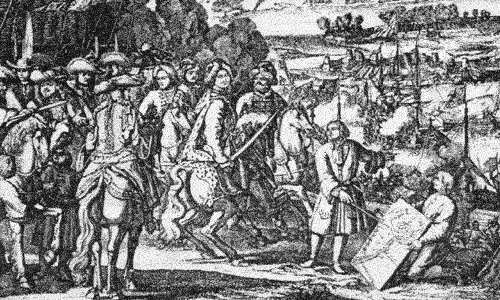
Engraving: Taking the Azov. Shein on the left hand of Peter, to the king, he is closer than others.
A group of horsemen behind the king (from right to left): Tolstoy, Sheremetyev, Lefort, Golovin, Gordon. Russians are still dressed according to their original traditions.
Preparation of the second Azov campaign
Peter considered that the main task in the new campaign was the river, sea component. The construction of a “sea caravan” (military and transport ships and vessels) began. This venture had many adversaries - there was too little time for this task (one winter), the question was difficult from the point of view of organization, resource attraction, etc. But the plan was unswervingly put into practice. One by one, decrees and orders were issued from Moscow to the governors and town governors on the mobilization of people and resources.
In January, 1696 of the year in Voronezh shipyards and in Preobrazhensky (a village near Moscow on the banks of the Yauza River, where the residence of Father Peter, Tsar Alexei Mikhailovich) was located, launched a large-scale construction of ships and ships. The galleys built in Preobrazhensky were dismantled, brought to Voronezh, collected there again and launched on the Don. Peter ordered the spring to make 1300 planes, 30 sea boats, 100 rafts. For this mobilized carpenters, blacksmiths, working people. The Voronezh region was not chosen by chance, for the local population the construction of riverboats was already a common trade for more than one generation. Total mobilized over 25 thousand people. Not only masters and workers traveled from all over the country, but also materials — wood, hemp, tar, iron, etc. — were carried. Work went quickly, and even more planes were built before the start of the campaign.
The task of building warships was solved in Preobrazhensky (on the Yauza River). The main type of ships under construction were galleys - rowing ships that had 30-38 oars, they were armed with 4-6 guns, 2 masts, 130-200 man of the crew (plus they could carry significant landing). This type of ship met the conditions of the theater of operations, galleys with their small draft, maneuverability, could successfully operate on the river, the shallow water of the lower reaches of the Don, the coastal waters of the Sea of Azov. The shipbuilding experience was used in shipbuilding: for example, in Nizhny Novgorod, the ship Frederick was built in NNXX, in the 1636 year in the village of Dedinov on the Oka - the ship "Orel", in 1668-1688 on Pereyaslavl Lake and in 1692 in Arkhangelsk with the participation of Peter was built several ships. For the construction of ships in Preobrazhensky, soldiers of Semenovsky and Preobrazhensky regiments, peasants, and artisans were widely attracted, who were summoned from settlements where shipbuilding was developed (Arkhangelsk, Vologda, Nizhny Novgorod, etc.). Among the masters, the Vologda carpenter Osip Shchek and the Nizhny Novgorod carpenter Yakim Ivanov enjoyed universal respect.
Throughout the winter, the main parts of the ship were made in Preobrazhenskoye: keels (hull base), frames (“ribs” of the ship), stringers (longitudinal beams going from bow to stern), beams (cross beams between frames), pillers (vertical supports supporting the deck) ), cladding boards, deck decks, masts, oars, etc. In February, 1696 prepared parts for the 22 galleys and 4 branders (a vessel filled with combustible substances for arson of enemy ships). In March, ships were transported to Voronezh. Each galley was delivered on 15-20 carts. On April 2, the first galleys were launched, their crews were formed from the Semenovsky and Preobrazhensky regiments.
In Voronezh, also laid the first large three-masted ships (2 units), with quite strong artillery weapons. They demanded a large shipbuilding complex. On each of them decided to install 36 guns. By early May, built the first ship - 36-gun sailing-rowing frigate "Apostle Peter". The ship was built with the help of the Danish master Augustus (Gustav) Meyer (he became the commander of the second ship - the 36-gun "Apostle Paul"). The length of the sailing-rowing frigate was 34,4 m, the width 7,6 m, the ship was flat-bottomed. In addition, the frigate had 15 pairs of oars in case of calm and for maneuver.
As a result, in Russia, far from the seas, in an extremely short period of time they created a “sea military caravan” - a detachment of warships and ships.
In the same period, the army was significantly increased (by half - to 70 thousand people), it was headed by a single commander - boyar Alexei Semenovich Shein (he was a participant in the campaigns of Prince Golitsyn, during the first campaign commanded the Preobrazhensky and Semenov regiments, thus knew the theater of war). The troops arrived from Moscow to Voronezh, where a whole armada of transport ships was waiting - around 1500 planes, rafts, barges, boats.
Frigate "Apostle Peter"
The second campaign
23 April, the first echelon of 110 transport ships with troops, artillery, ammunition, food began the march. After that, other ships, warships, began to go out. The 1000-kilometer trip was the first test for the crews, the skill of the sailors was honed in the process, the deficiencies were completed. The movement went quickly, went under sail and on oars, day and night. During the march, there was a process of developing the rules for organizing service on galleys, conducting sea battle - they were announced in a special “Decree on galleys”. The “Decree” referred to the order of signaling, anchoring, navigation in marching, discipline, and active combat operations against the enemy.
On May 15, the first detachment of galleys approached Cherkassk, where the vanguard of ground forces also arrived (troops marched on ships and land). Cossack intelligence reported that Azov has several enemy ships. 16 May Azov was besieged. May 20 Cossacks on their boats a sudden attack seized 10 transport ships (tunbas), in the Turkish squadron panic began. Taking advantage of the first success, the Cossacks were able to approach the Turkish squadron (it was at night) and set fire to one of the ships. The Turks took the ships, and one burned themselves, not having time to raise the sail.
On May 27, the Russian flotilla reached the Sea of Azov and cut off the fortress from sources of supply across the sea. Russian ships took positions across the Bay of Azov. In the same period, the main forces approached the fortress, they occupied trenches and earthworks, built in 1695 year. The Turks in their carelessness did not even destroy them. Russian artillery began shelling the fortress. At the mouth of the Don, two batteries were installed to strengthen the forces of the naval blockade. If the Turkish Navy broke through our fleet, these batteries would have prevented enemy ships from directly to Azov.
Taking Azov 18 July 1696 of the year. Engraving by A. Shhonebek. 1699 of the year.
About a month later, a Turkish squadron in the 25 pennants with the 4 ths. Detachment approached to help the Azov garrison. Having found Russian galleys that blocked the mouth of the Don, the Turkish admiral Turnochi Pasha stopped his forces at a considerable distance. June 28 Turkish fleet attempted to land troops on the shore. On the Russian ships prepared for battle, we took off the anchors and went to meet the Turkish ships. The Turks, seeing the readiness of the Russian flotilla for battle, retreated. As a result, the enemy fleet abandoned attempts to help the besieged garrison. This played an important role - the fortress was cut off from the supply of food, ammunition, reinforcements, and psychologically, it was a victory (the Turks were depressed).
The 10 of June and 24 of June were repelled by the attacks of the Turkish garrison, which 60 tried to help thousands of troops of the Crimean Tatars, who were camped south of Azov, beyond the Kagalnik River. 16 July completed preparatory siege work. 17-18 July Russian troops (1,5 thousand Don and Zaporozhye Cossacks) captured two Turkish bastions.
After that, the Turkish garrison was completely discouraged: the losses were heavy, the attacks failed, there was no help from Istanbul, the loss of basic positions began, artillery shelling caused considerable damage. On July 18 a white flag was thrown, on July 19 the garrison capitulated. The Russians entered the fortress. 20 July also capitulated the fortress of Liutik, which was located at the mouth of the most northern arm of the Don.
Plan siege and capture of Azov. 1696.
Results
- The whole of the Don became free for the Russian courts. Azov became Russian.
- Peter I, realizing the need to defend the conquest (the war continued), on July 23 approved the plan of new fortifications of Azov. The fortress was badly damaged by Russian artillery. Since Azov did not have a convenient harbor for basing the navy, already on July 27 chose a better place on Taganya Cape, where two years later they founded Taganrog.
- Voivod A.S. Shein 28 June 1696 was awarded the title of Generalissimo for military success (the first in Russia). Later, Shein was appointed Commander-in-Chief of the Russian Army, commander of artillery, cavalry and manager of a foreign order. Since 1697, Shein has led the work in Azov, the construction of the sea harbor in Taganrog, reflecting the constant attacks of the Tatars and Turks.
- Azov campaigns in practice showed the importance of artillery and fleet for waging war. And Peter drew conclusions from this, he cannot be denied organizational skills and strategic thinking. October 20 1696 of the Year The Boyar Duma proclaims "To be ships of the sea ...". Approved extensive military shipbuilding program 52 (later 77) ships. Russia begins sending nobles to study abroad.
- “To cut a window” to the south was completely failed, in order to complete the business it was necessary to capture Kerch (Old Russian Korchev), a city on the shore of the Kerch Strait, for free exit from the Sea of Azov to the Black. With a more radical solution to the problem, destroy the Crimean Khanate and seize the Crimean Peninsula. A fleet was needed to hold Azov.
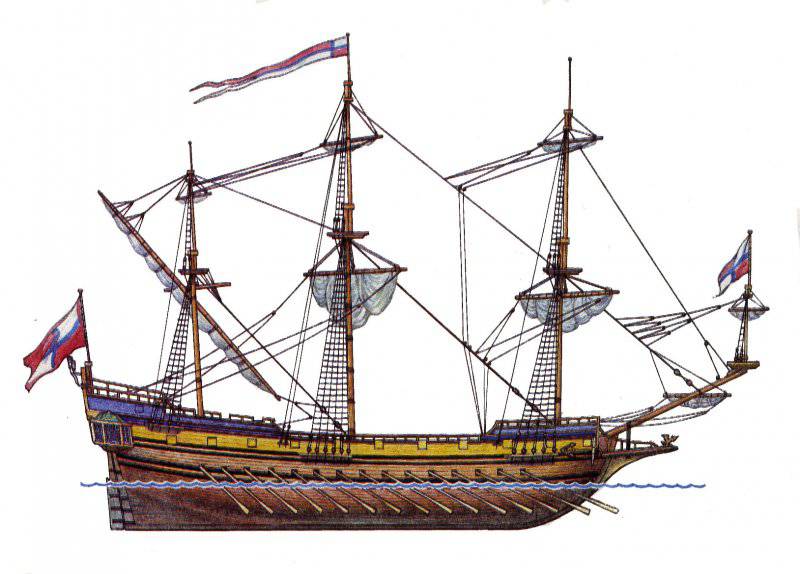
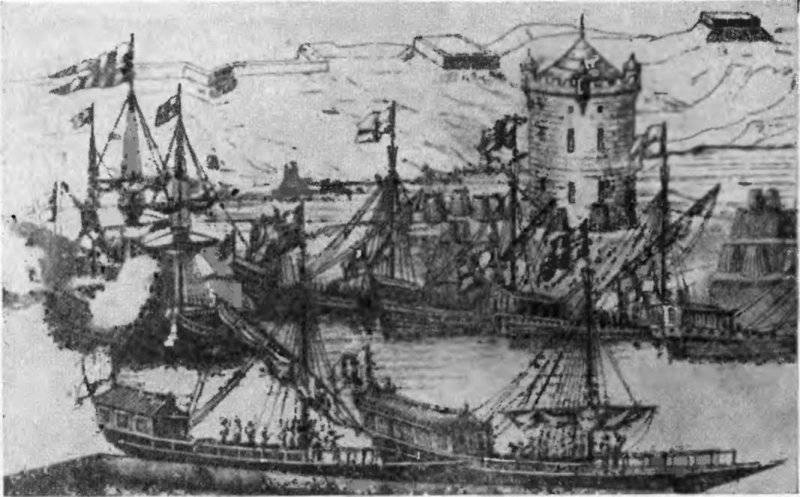
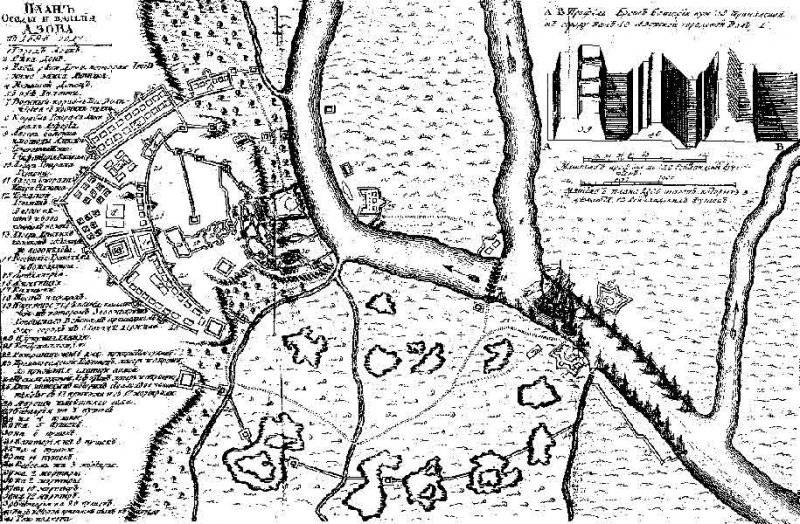
Information